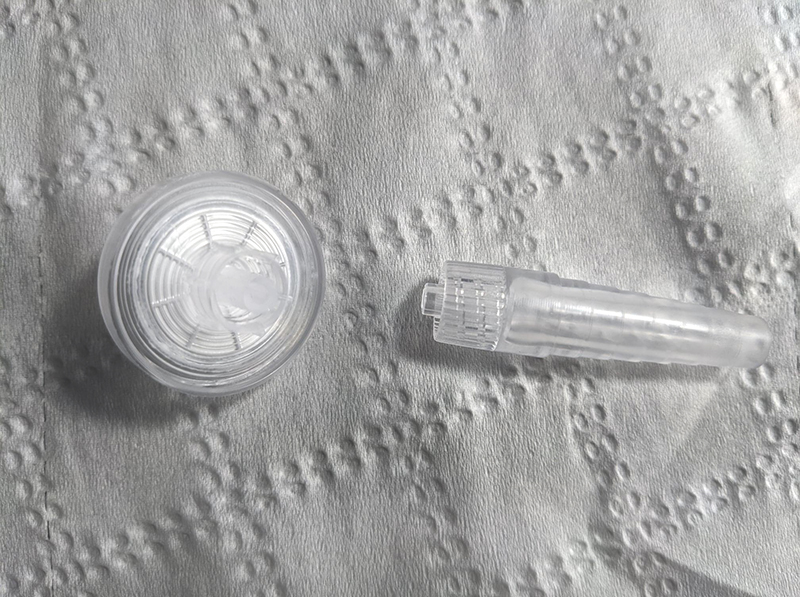My name is Milad and I use the LipSync (opens in a new window) device on regular basis. I am one of the engineers on Neil Squire’s Makers Making Change (opens in a new window) R&D team and I helped develop the LipSync device. As part of my role, I regularly use the LipSync to add new features and resolve software issues. As someone who is affected by respiratory related infectious viruses, I find it very important to clean and disinfect all the external objects that come in contact with my face.
The LipSync device uses a pressure sensor to receive inputs via sip and puff actions through a mouthpiece which comes with contact with your mouth. As we are going through a world pandemic with COVID-19, it’s important to minimize contacting your mouth and face with your hands and regularly sanitize or disinfect external objects such as the LipSync mouthpiece that comes in contact with your mouth.

Milad Hajihassan, Systems Developer at Neil Squire and a local gamer with a disability.
Sanitizing vs Disinfecting
Disinfecting and sanitizing are two terms that we tend to use interchangeably when it comes to removing germs and cleaning surfaces. It’s important to know the difference between these words during this difficult time. Washing objects with soap does not necessarily kill germs, but by removing them, it lowers their numbers and the risk of spreading infection. Sanitizing lowers the number of germs on surfaces of objects to a safe level by lowering the risk of spreading infection. Sanitizing can be used in environments with lower chance of being infected by viruses and bacteria. Disinfecting is the process that completely kills germs on the surfaces which is the recommended process for surfaces with high chance of being contaminated.1
The LipSync Device Mouthpiece
The LipSync mouthpiece is made of Cyrolite which is an acrylic-based multi-polymer used for creating medical applications. As such, it should not be cleaned with alcohol as it can get damaged. Acrylic is a nonporous material that dirt can’t penetrate. Instead, bacteria simply sit on the surface and you can wash it off without difficulty.2 We have gathered some information on the solutions that you can and can’t use to disinfect your unit.

Recommended Cleaning:
Benzalkonium Chloride (BZK) wipes are the recommend option to disinfect LipSync mouthpiece as (BZK) wipes are used to disinfecting skin and they are effective against viruses, fungi and bacteria without damaging the skin or acrylic-based polymers. They are safe to use and can disinfect the LipSync mouthpiece.3
Please see the steps below for cleaning procedures.
Steps to clean and disinfect your mouthpiece:

- Wash your hands for at least 20 seconds and sanitize them using sanitizer (or you may use gloves)
- Carefully remove the entire mouthpiece assembly from the LipSync by twisting left
- Remove the mouthpiece (long piece) from the filter (circular piece)
- Set the filter (circular piece) aside
- Wash the long mouthpiece using water and soap
- Make sure the all the surfaces inside and outside the mouthpiece are washed
- Let the mouthpiece dry on a clean towel/paper
- Disinfect all surfaces of the mouthpiece with Benzalkonium Chloride (BZK) wipes
- Rinse with water
- Let the mouthpiece dry on a clean towel/paper
- Discard any remaining solution if disinfecting solution is used
- You can use Benzalkonium Chloride (BZK) wipes to disinfect the outside surface of the filter but avoid washing the filter 8
- Add the mouthpiece back onto the filter
- Screw the mouthpiece assembly back on the LipSync
Do you need more LipSync device mouthpieces or filters?
In an effort to minimize risk to our LipSync users, we are offering free filters replacement during the COVID-19 pandemic. Please Email us to Request (opens in a new window).
Not Recommended:
Although Ethylene Oxide sterilization can effectively sterilize the surface of mouthpiece without damaging it, it requires additional equipment which is not available and sterilization process is not necessary.4 5
A 0.525% bleach solution is a strong and effective way to disinfect acrylic-based polymers, but not recommended on your mouthpiece because you probably want to avoid breathing into or touching your mouth with an object disinfected by bleach solution.6 7
%3 Hydrogen peroxide solution is another powerful disinfectant which can get rid of viruses and bacteria, but it can damage both acrylic-based polymers and the skin if it’s used in high concentration or not properly rinsed and dried.8
Resources:
- https://www.cdc.gov/flu/school/cleaning.htm (opens in a new window)
- https://homeguides.sfgate.com/disinfect-acrylic-tub-34231.html (opens in a new window)
- https://www.canadiansafetysupplies.com/Benzalkonium-Chloride-Antiseptic-Towelette-BZK-p/100010.htm (opens in a new window)
- https://www.cdc.gov/infectioncontrol/guidelines/disinfection/sterilization/ethylene-oxide.html (opens in a new window)
- https://www.fda.gov/medical-devices/general-hospital-devices-and-supplies/ethylene-oxide-sterilization-medical-devices#why (opens in a new window)
- https://www.thejpd.org/article/S0022-3913(05)80140-4/pdf (opens in a new window)
- https://www.verywellhealth.com/make-your-own-disinfectant-solution-998274 (opens in a new window)
- https://www.ncbi.nlm.nih.gov/books/NBK214356/ (opens in a new window)
- http://fcrc.albertahealthservices.ca/health-information/tracheostomy/doc/Home-Respiratory-Cleaning-Guide.pdf (opens in a new window)
- https://www.qosina.com/stepped-male-luer-lock-connector-80102 (opens in a new window)
- http://www.qosina.com/hydrophobic-filter-with-female-luer-lock-inlet-male-luer-lock-outlet-28213 (opens in a new window)
